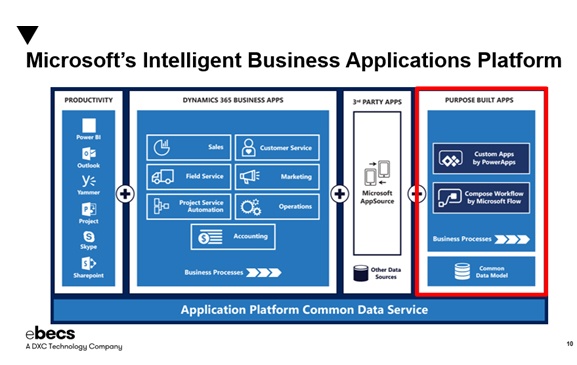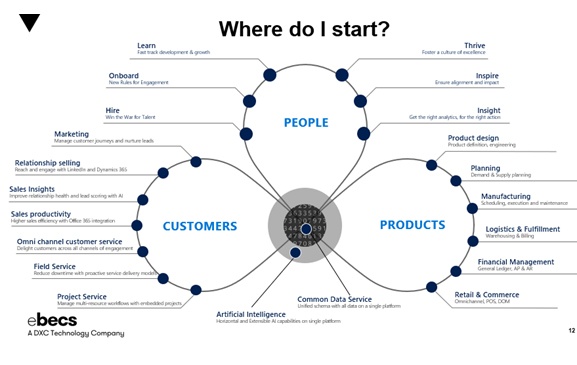Embracing Digital Disruption
You are here: >Embracing Digital Disruption
Deep Experience in Digital Solutions
A lot of what we do is around helping customers reinvent themselves from a technology perspective and a business perspective:
Cloud
- 800+ managed cloud clients
- Experts in managing complex, enterprise-scale migrations
- 310,000 managed virtual machines
- 20,000+ Microsoft professionals and 1,000+
AWS professionals
Applications
- Support for 1 million+ applications and 1,000 clients
- Deep expertise in modernizing, developing, testing and managing applications
- 50,000 application services professionals
- 30+ years of global delivery experience
Analytics
- 8,000+ analytics professionals
- Preconfigured analytics platforms available on premises or in the cloud
- Industry-focused approach to analytics solutions
Workplace and Mobility
- Largest workplace and mobility solutions provider, with 8.5 million user devices under management
- 24,000+ certified workplace engineers
- Recognized as leader by Gartner, Forrester, Everest and IDC
Security
- Global security services provider for traditional and next-generation IT environments
- 4,000+ security professionals
- Vendor-agnostic advisor and prime security integrator
- Global around-the-clock management and monitoring
- 10+ Intelligent Security Operations Centers globally
One of the key things about digital disruption is that the companies that are successful aren’t locked within silos. Very often the conversation is from the perspective of the end customer and the service you provide a customer, and when you think from that perspective, you end up looking across the breadth of applications and services. As IT leaders, we essentially become providers of those offerings and services.
So, we rarely ever do a project in isolation other than maybe workplace and mobility which is a specific area. Very often the problem is a particular business problem and we’ll pick aspects from each of these areas to solve the specific business problem.
What are Customers Thinking?
- I want to transform my business
- How do I enable my business to innovate on my new cloud?
- How do I fix my digital architecture?
- We need to change fast, what can we do?
- What other technologies can we use?
- I want to move out of my data centre
- How do I become more agile?
- Help me design my cloud architecture
- I am not seeing the benefits of being in the public cloud
- Help me create a digital investment strategy
- Can you protect my architecture?
- Help me take out cost and move to OpEx
Very often when people start getting into the cloud they think of many things like disaster recovery and backups, but rarely do they think about innovation. They think of cloud as a place to just put stuff.
One thing we hear a lot of when we speak to customers is ‘well, I’m in the cloud but I’m not sure what it’s all about. I’m in there and I think I am getting some benefit, but I see Gartner’s report which says what I should have, and I have something different. What happened?’
Disruption: To Accept or Embrace?
When you look at disruption in the organization, is this something you say ‘well it’s gonna get disrupted, I should do the best I can’ or do you say ‘great, finally someone is disrupting my industry. Now I can actually do something interesting with it.’
Some organizations would say ‘we’re getting disrupted, so let’s shore up our assets the best we can and squeeze out as much as we can from what we have and expect that some things will happen – or we’ll protect ourselves by building walls around the organization so no one can get in.’ Essentially establishing a mini monopoly of updates, which is a viable business approach but it doesn’t make your customers any happier.
Very often people think of disruption and they say ‘great there’s this disruption in the market, I must innovate. Let me get some R&D funding ready and throw some money at the problem.’ The goal is not to innovate, but to drive additional value for our customers. Do not innovate because you think you have to, or you will end up wasting a lot of time and money.
Very often we’re constrained by our industries, the people we work with and the customers we have and their expectations. Also, if you’re going to put the effort into disrupting something, don’t disrupt something which is actually causing you to make the effort.
Very often when you try to avoid disruption, you’re forgetting why disruption is actually happening. If you look at Airbnb, VRBO and Home and Away, they do basically the same thing and yet Airbnb is much more popular. I think it’s good to think why that is.
The How
- Have a process in place to continuously identify:
- Vulnerabilities
- Emerging business models
- Technologies that can address both
- Cultivate a culture of experimenting with new models and tools
- Empower the business to innovate in a secure, managed environment
- Break down silos and drive automation
- Fail fast to innovate faster
Today, most app platforms only see some business data….
Most applications across the board are fairly siloed because they were designed in a classic three-tier architecture where they control and manage their own data and everything else is irrelevant.
…but most processes in organizations are far more connected
So, as you start to innovate, what you usually see is you don’t have access to the data and even if you did, how would you put it together and where? What it prevents you from doing is having what is essentially a digital feedback loop.
You have key parties in the organization; your customers, employees, operations and products. Each of those generates data which you can generate insight from. We’re kind of good at this already, but we’re not very good at what happens after that. How do we take that data and feed it back into the business process? It’s not actually useful unless it’s making a change, which is why the loop is really important.
Everything now generates data and signals, whether it’s your customer’s social media or your products. So how do you capture them, how do you synthesize them and how do you feed them back so the loop gets maintained?
Microsoft’s Intelligent Business Applications Platform

The Innovation Platform
The Common Data Service
Very simply, this is a database running a data model which is published on GitHub which has classic business entities across CRM, ERP and HRM. It’s a pre-built database you can add stuff to and your business will map almost directly to it as well.
So instead of going to our business and saying ‘here’s the data, go figure out what you want to do’, we’ve said ‘no, we as an IT organization will provide you with an innovation platform managed by us, governed by us and we will provide that framework for you. Once you have that, you start exposing data across the organization. You’ve now broken those silos.
However, that’s not innovation currently, but just reporting and analytics. What you want is to find new ways to use this data to improve your business. That’s where Power Apps come into play.
Power Apps is basically a way for you to do drag-and-drop app building with no code and a local experience. We typically have the business stakeholders sit with us and co-build the app with us. You can collect data from multiple sources and you can build within Power apps itself so the ownership of these apps sits with the stakeholders themselves.
Where do I start?

When you take the proposition to your stakeholders, before they say they have a great idea, think about what impact this idea will have on your customers, people and products. It’s usually only a great idea if it connects those three in some way. Also, the way you connect everything through this is going to provide you with a lot of insight and a lot of leverage.
At the end of the day we’re not here to innovate. Our job is to figure out ‘what can I offer my business to let them innovate’ and that’s where the role really changes.
Key Takeaways
- Bring disruption to the table
- Offer an innovation platform to the business
- Innovate around Customers, People and Products
‘Everything now generates data and signals, whether it’s your customer’s social media or your products. So how do you capture them, how do you synthesize them and how do you feed them back so the loop gets maintained?’
Visit our website and attend our free educational events to find out more.
- About Us
- Partners
- Careers
- Contact us
- eBECS and the Microsoft Core Data Platform
- Microsoft Dynamics NAV in Property Management
- Microsoft Dynamics Nav Manufacturing Solutions
- Microsoft Dynamics NAV Cloud pricing
- Drive your Azure Momentum with SQL Managed Instance
- Compare Microsoft Dynamics AX VS NAV
- Microsoft Azure Data Centre Migration Guide
- Microsoft Dynamics 365 Business Central or 365 for Finance & Operations?
- Introduction to Microsoft Dynamics 365 for Finance and Operations
- Microsoft Dynamics 365 Business Central or 365 for Finance & Operations? Thank You
- Microsoft Dynamics 365 Business Central or Dynamics 365 Finance
- Compare Microsoft ERP Solutions
- Compare Microsoft ERP Solutions, Dynamics NAV vs Dynamics 365 Business Central
- Microsoft Dynamics 365 Business Central Price
- Compare Microsoft ERP
Categories
- AI (3)
- Azure (2)
- Business Insights (1)
- Canvas Apps (1)
- Common Data Service (2)
- Crisis Communication (1)
- CRM (3)
- Customer Data Platform (1)
- Customer Insights (1)
- Data Analytics/BI (29)
- Data Management (1)
- Data Warehouse (1)
- Dynamics 365 (33)
- Dynamics 365 Finance (1)
- Dynamics 365 Sales Insights (1)
- Dynamics 365 Supply Chain Management (1)
- Dynamics AX (50)
- Dynamics CRM (22)
- Dynamics Field Service (10)
- Dynamics NAV (10)
- Dynamics Project Service Automation (PSA) (15)
- eBECS (4)
- eBECS Marketing (1)
- eBECS Policies (1)
- ERP (2)
- Internet of Things (IoT) (15)
- Master Planning AX (4)
- Microsoft 365 (1)
- Microsoft Lifecycle Services (4)
- Power Apps (4)
- Power Automate (3)
- Power BI (1)
- Power Platform (6)
- Power VIrtual Agent (1)
- PowerApps (2)
- Project Service Automation (2)
- Quality Management (1)
- Sales (1)
- Surface Hub (3)
- Top Tips (1)
News
Upcoming Events - Register Now
Join our list
eBECS will invite you to webinars, events and keep you up to date with relevant news. You can unsubscribe at any time.









